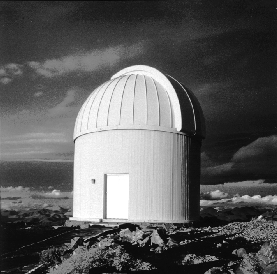

From 1971 to 1997, the University of Toronto operated a 60-cm telescope in the desert mountains of north-central Chile. This small telescope provided optical astronomers with a distinctive window to the southern skies. It was the only telescope in the Southern Hemisphere operated by Canada. Further, it and the Canada-France-Hawaii Telescope were the only Canadian telescopes at sites enjoying predominantly clear skies.
UTSO was located on Cerro Las Campanas, near the southern edge of the Atacama Desert (the driest in the world), where the air is clear and the atmospheric turbulence is low. Parts of the Atacama Desert in Northern Chile have not experienced any rainfall in recorded history. The rainfall at Las Campanas is less than a centimeter per year under normal conditions, and slightly higher during "El Niño." During a good year, 85% of the nights are usable and 65% are photometric. El Niño can drive the figures to as low as 70% and 50% respectively.
As a small telescope with good equipment at a clear, dark site with excellent seeing conditions, the HSHT filled a unique and very productive niche.

Helen Sawyer Hogg 60-cm Telescope
University of Toronto
Southern Observatory (UTSO)
01.- General Information: The 60-cm Telescope
Optical System : standard cassegrain, f/15
Focal Length : 914 cm
Primary Mirror : f/3.5, 213.05 cm focal length
Secondary Mirror : 17.21 cm diameter
Vignetting-Free Field : 10 cm diameter (37 arc min)
Finder/Guide Scope : Unitron 15-cm refractor, f/10
(40 arc min field)
Mount : German mount
02.- Geographical Specification of UTSO at Las Campanas
Latitude : -29 00' 30"
Longitude : 04h 42m 48s W (70 42' 00")
Altitude : 2280 meters
03.- Computer Systems at UTSO
UTSO had several computers. The names were formed by
UTSO plus a sequential number (UTSO1, UTSO2 and UTSO3). All
the computers had networking capabilities.
UTSO2 and UTSO3 ran under OS/2,
and UTSO1 under MS-DOS. In addition,
a Sun SPARCstation 2 was provided for the
exclusive use of the ongoing
MACHO project at UTSO.
Technical details of the three PCs follow:
- Computer Name : UTSO1
Computer : IBM PS/2 Model 30 80286 10 MHz
Math Coprocessor : 80287
RAM : 2 MB
Keyboard : Enhanced
LPT Ports : 1
COM Ports : 1
Display Type : Video Graphics Adapter (VGA)
Mouse : serial mouse, version 6.26
Disk Drives : A: floppy drive, 3.5" (1.44 MB)
C: hard drive
Cabinet Type : desktop
MS-DOS Version : 4.00
UTSO1 was housed in the master bedroom of
Casa Canadiense, ran MS-DOS, and
had Internet access.
- Computer Name : UTSO2
Computer : IBM ValuePoint, 486DX 33 MHz
Math Coprocessor : internal
RAM : 16 MB
Keyboard : Enhanced
LPT Ports : 3
COM Ports : 2
Display Type : VGA Color
Mouse : PS/2-style mouse, 6.25
Disk Drives : A: floppy drive, 3.5" (1.44 MB)
C: hard drive (323 MB)
D: hard drive (81 MB)
E: worm drive (940 MB)
F: CD-ROM
Cabinet Type : desktop
OS/2 Version : PC-DOS 2.10
UTSO2 was housed in the living room
of Casa Canadiense.
ATTACHED HARDWARE
- MR-2000C Ethernet/IEEE 802.3 repeater unit
- Corel SCSI WORM drive
- HP 35480A SCSI DAT drive
- Epson FX-85/185 printer
INSTALLED SOFTARE
- OS/2
OS/2 is a multi-tasking, multi-threaded windows-
based OS. OS/2 runs not only native applications,
but programs from some other
environments, notably MS-DOS and MS Windows.
OS/2 presents both a command-line interface
and a GUI. Since the interface in general resembes MS Windows NT,
a user familiar with NT will have no problems under OS/2.
- WordPerfect 6.0 word processor for OS/2.
- Networking programs, notably telnet, ftp,
and a facility for cross-mounting
between UTSO2 and UTSO3.
- Novatar software for controlling the DAT drive,
supporting reading and writing of DAT tapes.
- Optical-disk utilities ("Diagnostic," "Status," "Format")
for work with WORM drives.
- MIRA 2.0 image-processing software (similar to IRAF,
but for DOS/Windows and OS/2).
- Megastar sky atlas (uses one CD-ROM).
- Computer Name : UTSO3
Computer : IBM ValuePoint 486DX
Math Coprocessor : internal
RAM : 16 MB
Keyboard : Enhanced
LPT Ports : 3
COM Ports : 2
Display Type : VGA Color
Mouse : PS/2-style mouse, 6.25
Disk Drives : A: floppy drive, 3.5" (1.44 MB)
C: hard drive (323 MB)
D: hard drive (202 MB)
Cabinet Type : mini tower
OS/2 Version : PC-DOS 2.10
This IBM computer was located in the 60-cm telescope
dome. Hardware interfaces controlled
the complete operation of the telescope and
associated instruments.
INSTALLED SOFTWARE
- OS/2.
- Networking programs.
- Online documentation system (for manuals written locally).
- WordPerfect 6.0 word processor for Windows.
- PMIS 3.0 CCD acquisition software, running under
OS/2 Windows.
- Santa Barbara Instrument Group (SBIG) Autoguider
control software for ST-4 CCD: the heart of the autoguider
system for the 60-cm telescope.
- Encoder readout program,
for telescope pointing; written in Quick Basic.
- Routine for moving CCD filter wheel;
written in Quick Basic.
- Efits 2.0 and Efitsbat 2.0 for PMIS,
for managing the header section of FITS files produced
in PMIS. The two tools are almost identical, except that
Efitsbat is designed for batch-mode operation.
04.- Other Computer Systems
Internet access was provided by a Sun SPARCstation,
named "Charlie," in the Carnegie/Dupont 2.5-m
telescope computer room near UTSO. Accounts were established
for all observers, both residents and visitors.
-----------------------------------------------------------
Written by Felipe Mac-Auliffe P. (Alternate Resident).
Revised by Robert Garrison and Toomas Karmo, 2002 April 17.
-----------------------------------------------------------
 (Return)
(Return)